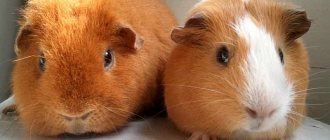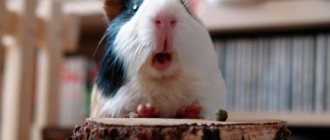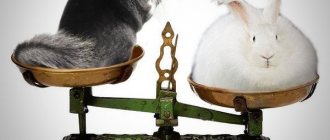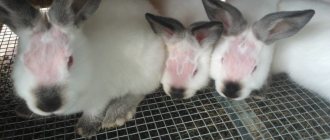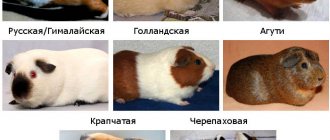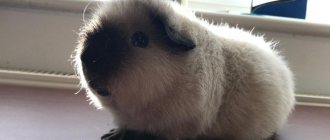Keeping a pet in the house means developing a sense of responsibility and constantly having a four-legged friend at hand. Keeping an animal in an apartment for a long time was quite problematic, however, now special breeds have been bred that are ideal for such an environment.
Furry friends are often made for children, which is why they pay attention to small animals. Often there are only two options - a rabbit or a guinea pig. Who is better for a child? Who should I choose?
Who is better, a rabbit or a guinea pig?
Of course, no one will give an exact answer to the question of who is better - this is subjective. However, the majority still lean towards overseas pets.
Guinea pigs and rabbits are similar in many ways. For example, both of them eat plant food, are not aggressive and live long.
However, according to other criteria, their content differs somewhat. The pig is a social animal and requires constant attention when kept alone. Rabbits, in turn, are quite calm and are not able to feel sad from lack of communication. If the future owner is unsure of his ability to devote a lot of time to the pet, it is better to get a rabbit.
Due to their sociality and intelligence, guinea pigs are trainable. They are also able to distinguish their name and show their love much more actively than a dwarf rabbit. Therefore, it is important to choose a creative name for your guinea pig. An equally important advantage is that there is no need for vaccinations, and they also have almost no smell when the cage is regularly cleaned (while long-eared ones can emit an unpleasant odor). Thus, if the future owner wants to get a loving animal to play with, it is better to get a guinea pig.
Furry animal
Chinchillas are charming exotic animals
with sad eyes. These rodents are native to South America. But in our climate they also feel great and can live up to fifteen to twenty years. Moreover, they are very unpretentious.
Yulia Markunas reports
, chinchilla breeder:
- I first saw a chinchilla 5 or 6 years ago.
She blew me away. Such a soft, fluffy little creature. A month after the appearance of my first chinchilla, I realized that he was sad with us, and I had to think about a mate for him. Keeping them is simple and inexpensive, but a lot of time is spent on homemade preparations - we prepare hay, separately dry nettles, dandelions and leaves... But all this was not because it was “necessary”, but because I wanted... The chinchilla is a nocturnal animal, so during the day no need to disturb her sleep. At temperatures above 25 degrees, the furry can suffer from heatstroke. The easiest way to feed them is with special (not very expensive) food and hay, adding fruits and grass.
The chinchilla also needs special sand for bathing (sold in pet stores) and conditions for physical activity, at least a wheel. In principle, it is not particularly different in maintenance from an ordinary rat, but it is much more beautiful.
Choice in favor of the child
If you are choosing a pet for a child, the choice should fall on a guinea pig. These rodents are quite easy to catch because... they are not particularly fast. You can play with them for quite a long time, they love this activity and do not get tired. They also enjoy being held and showing affection in every way possible.
The only downside is that pigs can be easily injured. Some care will be required. Otherwise, it is quite miniature and a good pet option for a child.
Although, of course, you need to listen to the child’s opinion. If your baby wants to have an “eared one” after all the explanations and explanations about the advantages of mumps, you should not refuse. Rabbits, even though they are larger and have more character, are also capable of love and make great friends.
Which is better, a rabbit or a guinea pig?
To make a final decision, it is important to first evaluate the pros and cons of both pets and understand how they differ. The table clearly demonstrates the differences between animals.
Lives from 5 to 8 years
| Comparison criterion | Decorative rabbit | Guinea pigs |
| Lifespan | Usually 8-12 years | |
| Nutrition | Plant food | |
| Diet | Granules are purchased at pet stores and greengrocers. | Requires several types of food, there are dietary restrictions |
| Behavior | There is no aggression and cannot scare children | They have a calm character and are shy in the first days. |
| Relationship with the owner | Able to demonstrate a positive attitude | They are affectionate towards their owners, recognize their name, and are able to sit in their arms for hours. |
| Need for attention | Does not require constant attention | Social animals, when kept alone, require attention |
| Veterinary control | Frequent vaccinations are not required, but not all clinics work with rabbits that are susceptible to cold | Does not require vaccination, susceptible to disease |
| Uncontrolled movement around the house | Necessary for maintaining physical activity, harms furniture and decor, can be poisoned by ornamental plants | Regular walking outside the cage is required, you can limit yourself to enclosures |
| "Catchability" | A child doesn't always manage to catch a rabbit to play with. | Not distinguished by increased agility or “cruising” speed |
| Toilet | Toilet trained, but may not be able to control urination in their hands | Difficulty or no toilet training at all |
| Smell | May emit an unpleasant odor | They do not have their own unpleasant odor |
| Training | Amenable, but bad | Know your name and follow simple commands |
| Noise | Most of the time they are quiet | Noisy, although the sounds are pleasant to the ear |
| Dimensions | Larger than guinea pigs | Easily fits in the hands of a preschooler |
| Housing | Requires regular and thorough cleaning | |
| Reproduction | If there is a different-sex couple, quick and regular | |
Rabbit & chinchilla: choosing a pet
“Which should I get, a rabbit or a chinchilla?” This question is often asked by people who want to get a new pet. To help you make your choice, let’s now compare these charming fluffies according to the most basic parameters.
Smell and tray
The main factors of interest to a person planning to get a pet. Chinchilla doesn't smell. In the cage he chooses one corner for the toilet, washing which completely eliminates unpleasant odors from feces. When moving around the apartment, he can shit anywhere. There is a smell from the rabbit. The tray and cage will have to be washed regularly, sometimes 2 times a day. But the rabbit easily gets used to the tray, into which it runs while walking around the room.
Health and hygiene
Both rabbits and chinchillas react poorly to drafts and temperature changes, as well as loud, sharp sounds and smells. The rabbit needs to be regularly bathed, combed, and its claws trimmed. The chinchilla bathes in special sand in a special bath; no other care for its coat is required. If a rabbit gets sick, it is easier to cure - veterinarians deal with them tens of times more often than with chinchillas. In addition, there are vaccines for rabbits that help avoid many diseases.
Character and behavior
It is difficult to hold and pet a chinchilla. But unlike the affectionate rabbit in this regard, she will not become aggressive during puberty and hunting. The rabbit can be carried in your arms, stroked and scratched, the big-eared one will be delighted with this. Willingly take part in children's games and make friends with a cat or dog. Until he grows up, he will be sweet and affectionate. And then an increase in aggression is possible: the rabbit will attack, scratch, bite. The changes in the behavior of female rabbits become especially sharp.
Diet
Both species are considered problem-free in nutrition. Grass, hay, grain mixtures, fruits and berries - the animals’ diet is almost identical. There are no sharp differences in one direction or another.
Ease of maintenance and walking around the apartment
Both animal species require cages. An inexpensive standard cage is suitable for a rabbit, but a chinchilla cage requires a special one and is not cheap. Given nighttime activity, the cages are located away from the bedrooms. And while a rabbit can be trained not to make noise at night, this trick won’t work with a chinchilla. The cute creature puts on such nightly concerts that there may be complaints from neighbors. The disadvantages of a rabbit include peeled wallpaper, chewed wires, damaged furniture, and smelly urine marks. Although the chinchilla does not refuse the opportunity to sink its teeth into everything that catches its eye. In addition, it easily squeezes into the narrowest cracks, which can lead to unpredictable results.
Let's summarize: If you have the opportunity to devote a lot of free time to an animal, a rabbit is suitable for you. You can play with it and walk with it, taking it out on a harness, the rabbit can be trained - the animal easily masters simple tricks. If the absence of odor and a minimum of fuss with cleaning the cage are more important to you, get a chinchilla. Watching the jumps and games is also a pleasant pleasure. But all her walks around the apartment must be under strict control.
Subscribe
to our channel and read new articles, blogs and topics daily.
Our VKontakte and Facebook pages. There are also a lot of interesting things there!
Some images on our channel are taken from open sources, Yandex Images and social networks.
Source
Who will be the best pet for a child?
When deciding who is best to have at home, you should also pay attention to the character of your son or daughter. Guinea pigs are easier to care for, so if a schoolchild or preschooler is willing to spend a couple of hours a day on an animal and spend the rest of the time doing their own thing, then the clear choice is an “overseas” pig.
The guinea pig is a more passive animal than the rabbit and loves to sit on hands
When a child needs a friend to whom he is ready to devote all his attention, and the parents support him and help in his care, which also unites the family, then buying a decorative rabbit can be an excellent solution. An additional bonus is that an exotic pet will interest the owner’s friends and allow him to build new social relationships.
A rabbit is larger than a guinea pig and more active
Sometimes, when thinking about whom to choose, future owners rely on such a parameter as “intelligence.” But it is necessary to understand that each animal is individual and can demonstrate completely unexpected skills, therefore, the “smarter” criterion is not always justified.
Opinions about the possibility of rabbits and pigs living together are ambivalent. In a number of literature you can find information about the safe cohabitation of the two species, however, experienced breeders recommend separating animals into cages: rabbits can harm their harmless neighbors.
For a comparison of a chinchilla and a guinea pig, read our article “Who is better: a chinchilla or a guinea pig?”
Guinea pig or rabbit: which is better for a child?
Keeping a pet in the house means developing a sense of responsibility and constantly having a four-legged friend at hand. Keeping an animal in an apartment for a long time was quite problematic, however, now special breeds have been bred that are ideal for such an environment.
Furry friends are often made for children, which is why they pay attention to small animals. Often there are only two options - a rabbit or a guinea pig. Who is better for a child? Who should I choose?
Hamster and chinchilla
The significant difference in size and character traits of both animals precludes their coexistence in the same dwelling. First of all, chinchillas require a very large cage, completely unsuitable for hamsters. Both species can be aggressive, and if the chinchilla is only slightly harmed, the small rodent can be eaten by a larger animal.
A hamster's diet often includes fresh pieces of vegetables and fruits, but for chinchillas, raw food is contraindicated, so pets should be kept separately from each other.
Love for chinchillas forever
Many people choose to keep chinchillas at home, and these animals usually live from 6 to 10 years. They are very friendly and active, so it is better to house them in spacious metal cages with a plastic tray and various devices for an active life. During the day they prefer to rest, falling asleep, and in the evening they lead a hectic life. They rustle with various objects that are in the cage, but you can quickly get used to the sounds of activity they make.
Chinchillas are excellent companions for people of all ages, especially children, and can be kept alone. However, they are very sociable animals and live well in pairs. Having started a family of these rodents, you will be able to observe interesting scenes of family life. Basically, they always accept the second animal well, and later they frolic together and run around the cage, although most often the female chases the male when he shows his courtship towards her. They either make noise and run around the cage, sorting things out, or they sit next to each other and gently stroke each other.
Chinchillas need a varied diet. This includes vitamin-enriched food and grass, vegetables and nuts, dry and fresh fruits, hay, and they also have an interest in human food. There should always be a drinking bowl with fresh water in the cage. Animals also love water treatments, so put a bathing suit in their house. Usually it is put on for a couple of hours every day, without leaving it on all the time.
Experts name several advantages of keeping chinchillas in your home:
- get along well with people and other pets; simple care suits them; become tame and amenable to training; practically do not bite and do not show aggression; have a fairly long life (in some cases they live up to 20 years); rarely get sick; do not have an unpleasant animal odor; very beautiful, funny and fluffy animals with an interesting character.
By the way, do you know how to give vitamins to a chinchilla? Look, it's interesting!
Who is better, a rabbit or a guinea pig?
Of course, no one will give an exact answer to the question of who is better - this is subjective. However, the majority still lean towards overseas pets.
Guinea pigs and rabbits are similar in many ways. For example, both of them eat plant food, are not aggressive and live long.
However, according to other criteria, their content differs somewhat. The pig is a social animal and requires constant attention when kept alone. Rabbits, in turn, are quite calm and are not able to feel sad from lack of communication. If the future owner is unsure of his ability to devote a lot of time to the pet, it is better to get a rabbit.
Due to their sociality and intelligence, guinea pigs are trainable. They are also able to distinguish their name and show their love much more actively than a dwarf rabbit. Therefore, it is important to choose a creative name for your guinea pig. An equally important advantage is that there is no need for vaccinations, and they also have almost no smell when the cage is regularly cleaned (while long-eared ones can emit an unpleasant odor). Thus, if the future owner wants to get a loving animal to play with, it is better to get a guinea pig.
Maintenance and care
You can buy a long-haired guinea pig either in a nursery or through an advertisement from breeders or simply from kind people. They reproduce amazingly in captivity, there is no shortage.
Guinea pig family
The price depends on the class - pet class - from 1500 rubles, breed class - up to 2000 rubles, and show class - up to 3000 rubles. Maintenance and feed are also inexpensive.
Cell
Although this is a fairly large animal, and the pig should spend most of its time walking around the apartment, it still needs its own corner - a cage or a spacious aquarium.
Choice in favor of the child
If you are choosing a pet for a child, the choice should fall on a guinea pig. These rodents are quite easy to catch because... they are not particularly fast. You can play with them for quite a long time, they love this activity and do not get tired. They also enjoy being held and showing affection in every way possible.
The only downside is that pigs can be easily injured. Some care will be required. Otherwise, it is quite miniature and a good pet option for a child.
Although, of course, you need to listen to the child’s opinion. If your baby wants to have an “eared one” after all the explanations and explanations about the advantages of mumps, you should not refuse. Rabbits, even though they are larger and have more character, are also capable of love and make great friends.
Recently, there has been a real fashion for buying pets. Moreover, what should be especially noted here is that we are not talking about the dogs and cats that are familiar to everyone, but about guinea pigs, hamsters and decorative rabbits. This trio, in the literal sense of the word, has taken over city apartments; more and more people give preference to them, forgetting about dogs and cats. In principle, there is nothing surprising here, because these animals are very small, they can be kept in a cage, and they eat little.
Guinea pigs vs. Decorative rabbits
The choice between a decorative rabbit and a guinea pig becomes a real agony for many. Both animals have their own characteristics. Some people prefer guinea pigs, while others prefer decorative rabbits.
So, first of all, it should be noted that guinea pigs for the most part are, in fact, one animal, that is, guinea pigs are all the same. Well, decorative rabbits are distinguished by a variety of breeds. It is also important that the difference between the breeds is colossal. There are breeds, for example, the Hermelin and Fox rabbit breeds, which are distinguished by their small size; they weigh around several hundred grams, and their dimensions are comparable to the size of a month-old or one-and-a-half-month-old kitten. There are also large breeds, for example Belka; some classify this breed of rabbit as a skin breed or even a meat breed, but in fact it is more like a decorative one. These rabbits weigh more than three kilograms. Separately, it is necessary to mention the lop-eared rabbits, as well as the Angora rabbits, the former have large drooping ears that reach to the floor, and the latter have so much hair that from a distance they seem like a ball of fluff, and not an animal. By the way, it is quite easy to buy both of them; decorative rabbits at zootovary are also very inexpensive, and they are also sold with documents. Pigs can also be bought in many online stores in the country, and of course in offline stores.
Popular pet rodents
The most popular species that are suitable as pets include hamsters, mice, rats, chinchillas, guinea pigs, gerbils, chipmunks and degus. They all differ from each other in appearance and have their own characteristics.
Decorative mouse
She is a relative of the common house mouse and one of the most popular pets. The decorative mouse is ideal for those who cannot have a large animal, but dream of a four-legged pet.
The domestic rodent is easily tamed and is able to distinguish its owner from other people. He willingly climbs into your arms, but has the ability to cleverly hide.
On a note. House mice emit a specific odor that cannot be eliminated even with thorough cleaning. Therefore, it is not recommended for allergy sufferers.
Decorative rat
These are very smart and loyal pet rodents. They love company and try in every possible way to attract the attention of their owners.
Decorative rats do not want to run away and are easy to train. They can be trained to respond to their nickname and follow basic commands like “Home!” or “Come to me!”
These pet rodents love to sit on their owner's shoulder and communicate through squeaks.
Rats are very clean and very quiet animals. They are relatively quiet and with regular care will not smell unpleasant.
Degu
These are small domestic rodents, similar to jerboas. They are small in size and weigh only 200-300 g with a body length of about 30 cm. And their hard, dense fur is colored chestnut-gray or brown-yellow. Degus easily adapt to apartment living and live in captivity for 6-8 years.
These exotic ornamental animals are easy to care for. But for a comfortable stay they need various labyrinths, burrows, houses and sand baths.
Interesting! Degus have several alternative names. They are often called Chilean squirrels or bush rats.
Chipmunk
This miniature animal weighs up to 130 g with a body length of no more than 15 cm. It has a memorable appearance and stands out from the rest by the presence of 9 longitudinal stripes on its back, which are colored dark and light.
The rodent does not get along well with its fellows and needs a separate cage. The chipmunk is very clean and easily learns to relieve itself in a strictly designated place.
Gerbil
Scientists know more than 100 species of gerbils. But only representatives of the Mongolian species can be tamed. The size of gerbils varies from 5-20 cm, and their weight is 15-200 g.
These rodents have a short sandy coat and a neat tuft at the tip of the tail, along the entire length of which a thin fluff grows. In natural conditions, gerbils live in families.
Loneliness is bad for the health of these animals, so it is better to keep them in pairs. These rodents have a friendly disposition.
On a note. Active and curious pets are constantly on the move and create a lot of noise. They enjoy dragging their toys around and throwing their food around. Therefore, you can have a gerbil at home only if the potential owners do not like silence and are not lazy to clean.
Guinea pig
These are very sociable and social rodents. Pets need constant attention from their owners and do not tolerate loneliness well. Guinea pigs are very vulnerable, but get along well with same-sex relatives.
Unpretentious and trusting domestic rodents are peaceful towards people and are considered the safest pets for preschool children.
Chinchilla
These large domestic rodents have a soft, pleasant to the touch coat of a beautiful gray color. They are nocturnal and have a cautious, timid disposition. Chinchillas do not require specific care, but they do need a spacious cage with shelves.
Chinchilla
On a note. Chinchillas do not have sweat or sebaceous glands, so they do not emit a specific odor. These pet rodents do not shed and are considered hypoallergenic animals.
Hamster
These touching and funny pets are active at night and do not like to share territory with their brothers.
Hamsters are easy to tame, but if handled incorrectly, they become capricious and disobedient.
Other rodents
Not all types of ornamental rodents are in equal demand. Less popular, but very interesting varieties include:
- Squirrels.
These agile and fast long-tailed animals with black shiny eyes are easy to tame and become attached to people. Fluffy pet rodents need a spacious home and change their coat twice a year. If you provide squirrels with adequate nutrition and good care, they can live up to 15 years. - Sony.
These small animals resemble both squirrels and mice at the same time. Small domestic rodents readily make contact and are well tamed. Active and mobile dormice need a spacious cage with shelves, ladders, etc. - Jerboas.
These tiny mouse-like animals have a funny appearance. Jerboas are easily recognized by their huge ears, long hind legs and jumping style of movement. These domestic rodents have a harmless, affectionate disposition and easily get used to being handled. - Rabbits.
These domestic rodents are endowed with a sociable disposition and need constant interaction with people. Decorative rabbits easily get used to the tray and can walk on a harness with a leash. - Marmots.
These large domestic rodents are very curious and intelligent. Smart and active marmots easily make contact with people and are quite amenable to training. They eat vegetables and fruits, but enjoy eating grains. To keep a groundhog, it is better to choose a spacious cage with several complex locks. Otherwise, there is a risk that an enterprising domestic rodent will cope with a simple deadbolt and go traveling around the apartment.
Squirrel in a winter coat
Red squirrel
Sonya
Jerboa
Decorative rabbits
Marmots
Caring for your pig
At first, the pig will be afraid of everything; during this period of adaptation, just try not to notice the animal. Excessive attention to yourself will only frighten the guinea pig even more. But this is only the first couple of days until she gets used to the new home and understands that her life is not in danger.
After getting used to it, on the contrary, under no circumstances leave the animal to its own devices, be sure to play with it, teach it tricks, communicate - this is a social animal that can become wild and embittered.
The pig must be tame
Be sure to give the animal a name. Guinea pigs have a fairly developed brain and intelligence, they are able to learn simple tricks, and it couldn’t be easier for them to respond to their name.
Water treatments
Guinea pigs, contrary to their name, do not like water. You should only take a bath if necessary, if the animal has been rolling around in the mud. Better yet, watch the video:
After a bath, be sure to dry it with a towel, otherwise the animal will catch a cold in the draft. You shouldn't use a hairdryer either.
Animal diseases
Since we mentioned diseases, let us present the painful state of mumps:
- Lethargy, reluctance to move;
- Squinted or often completely closed eyes;
- Arrhythmic breathing, cough or wheezing;
- Thirst;
- Externally unhealthy coat, easily plucked;
- Discharge on the eyes and nose;
- Minor trembling in the body;
- Frequent bowel movements, diarrhea;
- Convulsions;
- Parasites.
If any of the above symptoms occur, quickly contact a veterinarian, do not let the animal die!
Self-medication is unacceptable; antibiotics can only be prescribed by an experienced doctor. Although this may turn out to be a banal allergy to food, you shouldn’t hope for it.
A sick animal will begin to seek solitude to rest, will stop making characteristic sounds when meeting its owner, and will generally begin to behave atypically. Keep an eye on this.
Origin
The guinea pig originates from South America. Guinea pigs were domesticated back in pre-Inca times. About 400 years ago, the animals were brought to Europe under the name guinea pigs or guinea pigs.
The ancestor of domestic pigs was the wild guinea pig living in the mountainous regions of Chile. These animals live in burrows in families of up to 10 individuals.
These animals have a unique cute appearance and a gentle disposition. Pigs do not climb furniture or walls or swing on curtains. These animals are awake during the day and sleep at night. Pigs rarely scratch or bite; even small children can care for them.
They recognize the person who is caring for them and greet his appearance with a sharp whistle or soft grunt.
A guinea pig can be trained to come when called, respond to a name, “serve” and ring a bell.
